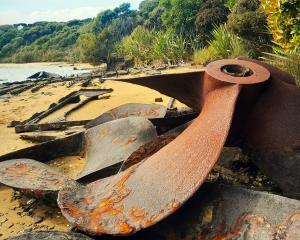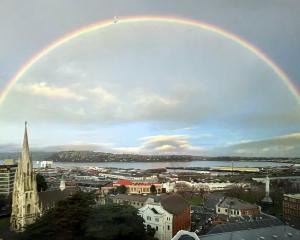Chas Hayward was the chairman of the council's reserves committee.
In May, 1953, he told the Evening Star the garden might "someday" have a "small zoo" with Gibbon monkeys "as the nucleus" - just like Adelaide's zoological gardens which he had recently visited.
He believed Gibbon monkeys would acclimatise to Dunedin's weather and would attract more children to the garden.
But, he advised, "very careful consideration" would need to be given to the proposal before anything definite was done.
Five weeks later, council records show, the reserves committee approved his idea and began considering sites for a "monkey house".
The Dunedin Amenities Society, set up in 1888 to protect and preserve such city assets as the garden, quickly filed an objection.
Not only did it think the garden "an unsuitable spot" for a monkey house, it considered, more importantly, that there would be "an element of cruelty" in keeping monkeys in Dunedin because of the severity of the city's winter weather.
And, in case those arguments were insufficient, the society reminded the council: "the behaviour of these animals is questionable".
Four days after the council received the society's objection, it also received advice that the Wellington City Council would be "pleased to present" a pair of bonnet monkeys to Dunedin, provided permits could be arranged and that the monkeys would be housed "in conformity with the regulations".
"On receipt of the necessary permit from you, arrangements will be made for the monkeys to be forwarded," wrote the Wellington town clerk.
The council accepted the monkey offer - later referred to as "the gift" - and a further offer from Cr Hayward to provide the garden with a monkey house.
"The gift" did involve some "moneys" being forwarded to Wellington but the amount is not specified in council records.
Running parallel with the monkey story through the latter part of 1953 was another story about the council elections of that year - and the contest for the mayoralty.
The incumbent was a Mr L. M. Wright, a renowned former athlete, a Citizens' Association candidate and a man with 12 years experience on the council and three as mayor.
One of the two other contenders was Cr Hayward who had served overseas in World War 1, had served six years on the council and was in business in the city, "on his own account".
Unfortunately for Mr Hayward, the very day he "reaffirmed" his intention of standing as an independent, the Evening Star declared in its editorial, under a heading "No reason to change city mayoralty", that Mr Wright's services as mayor had been "outstandingly useful . . ."
And, three days later, the paper declared Cr Hayward was "allowing personal ambition to outstrip his judgement" and was prejudicing his chances of gaining the mayoralty in future.
"Cr Hayward's determination to stand becomes mischievous.
He cannot expect to do more than split the votes of the other candidates."
At about this point the tale of Cr Hayward's monkey house goes rather cold.
The council has no record of any monkeys being "forwarded" from Wellington and the daily newspapers, as far as this reporter could determine, have no record of their arrival or of any official monkey-house openings or any photo opportunities for Cr Hayward.
In November, Cr Hayward's local government career ended.
He lost not only the mayoralty by a considerable margin but also his seat on the council - polling 3000 votes fewer than the bottom-placed elected councillor, Mr T. K. S. Sidey.
At some point, however, without any obvious fanfare, two bonnet monkeys did arrive in Dunedin and in December Mr Hayward was thanked by Cr Sidey for "his gift".
Cr Sidey said Mr Hayward had spent "a lot of money" on the house and had gone to considerable trouble to obtain the monkeys which were "giving much pleasure to the young people of the city".
While trying to piece together the monkey story, the Otago Daily Times recently posted, online, a plea for information.
The story attracted a creditable 1000-plus hits but little information that was of great use.
"Hardcase", for example, remembered at age 9 seeing the "robust" brass sign about not feeding the monkeys and the slot for donations but "... to be perfectly honest, I don't seem to have any vivid memories of actually seeing monkeys".
There is no doubt there were monkeys, and in April 1954 they finally began attracting press attention.
The Evening Star reported there was a "very proud" mother in the garden.
"Jean the bonnet monkey who was brought to the gardens in December with her husband Jack, produced an offspring."
Given that the gestation period of the bonnet monkey is 166 days, it seems that prior to their arrival in Dunedin the two adult monkeys had been involved in some of the behaviour the Amenities Society had warned about.
The Star wrote that Jean was "in a coy mood" and declined to pose for a photograph.
"When a cameraman entered the cage she at once fled to the top of the tree, the baby clinging in front of her, and there she sat with a screen of twigs between her and the camera."
The reporter suggested the conversation between Jack and Jean went something like this: "Don't you trust these queer-looking people m'dear. Stay where you are".
It was noted the monkeys were provided with a balanced diet of "milk sops" (bread soaked in warm milk), glucose, carrots, cabbage, lettuce, wheat and peanuts, and it was also noted people ignored the signs asking them not to feed the monkeys.
Three months later, "adverse comments" were being made in the press about the state of the monkey house.
"Many visitors to the monkey house and the aviary maintain the animals and birds are suffering from the cold.
"One resident has stated the site is a dreadful place in which to have the animals and birds housed and one could not help pitying them on their miserable look."
The superintendent of reserves, Mr M. R.Skipworth, "emphatically" refuted the criticism, saying experts had told him bonnet monkeys came from "high up in the Himalayas" and were "ideally suited" for Dunedin.
"It would be foolhardy, Mr Skipworth added, to install any kind of heating inside the monkey house.
The monkeys would be going continually from warm air into cold temperatures and in time they would develop pneumonia.
"I am afraid some of the public has not got the faintest idea what it is talking about.
A lot of people just rush in thinking they know everything but it is evident that they don't," Mr Skipworth said.
The three monkeys survived through the winters of 1954, 1955 and 1956.
In his history of the Dunedin Botanic Garden, Eric Dunlop noted the three monkeys did enjoy "a brief period of freedom" in 1955 when a storm damaged the monkey house.
Then, in October 1956, the Dunedin town clerk reported to his Wellington counterpart Jean had died from pneumonia.
Soon afterwards, according to council minutes, Mr Skipworth reported the two remaining monkeys escaped from their pen while being fed.
"Before being recaptured, the young monkey was run over by a motorcar and killed."
The Dunedin Naturalists' Field Club wrote that it considered the lone monkey, Jack, should be "disposed of" either by sending it to another zoological garden or by "painlessly destroying it".
However, the council was not yet willing to quit the monkey business and ordered a replacement from Wellington.
Finally, in 1967, and back to just one monkey, the council brought to an end its 13-year association with monkeys.
Reserves committee chairman J. G. Barnes told the ODT his committee felt "Jock" would be better off in the company of other monkeys.
"Mr Barnes raised the matter with the committee after an ODT correspondent stated visitors to the city were horrified that the little monkey had lived alone at the gardens for at least four years."
The council gave Jock to a man in Picton, apparently, in exchange for some birds and so ends the tale of Dunedin's monkeys - as far as it is known.
It is not clear whether Dunedin's monkeys were Macaca radiata radiata or Macaca radiata diluta but they were generally known as "bonnet" monkeys because of the thatch of long hair on their heads.
Bonnet monkeys are endemic in southern India and can grow to 60cm, with a tail of a similar length, and can weigh up to 7kg.
They are happy living alongside people - sharing their food and crops when the opportunity arises.
Bonnet monkeys continually strive to improve their social standing, with each "troop" of monkeys led by an alpha male and an alpha female.











